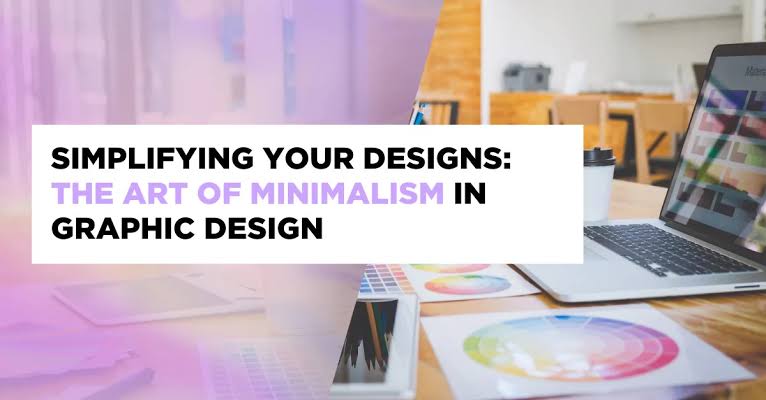Explore the significance of minimalism in graphic design, including its benefits such as clarity, improved user experience, and enhanced brand identity. Learn how minimalist design principles can be applied across various mediums to create impactful and engaging visual content.
The Significance of Minimalism in Design: Streamlining Intricacy
Introduction
In the constantly changing world of design minimalism has become a design philosophy with its impact. At its core minimalism is about the concept of “less is more” focusing on simplicity and clarity by stripping away elements. This method not makes designs cleaner but also boosts the effectiveness of conveying messages visually. This article delves into the importance of minimalism in graphic design exploring its advantages, uses and the influence it has on crafting engaging visual content.
Understanding Minimalism in Graphic Design
Graphic design with a style that features lines, color schemes and a focus on key elements. The aim is to produce designs that are visually appealing and practical. By prioritizing elements and removing distractions minimalist designs communicate messages effectively and let the content shine. This philosophy is based on the idea that simplicity can enhance user satisfaction and enhance understanding.
Benefits of Minimalist Design
Clarity and Focus
One of the advantages of living is its capacity to offer clarity and concentration. By removing distractions minimalist aesthetics guides the viewers focus towards the message or prominent aspects of the design. This clarity holds significance, in todays fast moving digital landscape where individuals frequently encounter an overload of information. A minimalist approach aids users in grasping the idea swiftly without being sidetracked by elements.
Improved User Experience
Minimalism enhances the experience by crafting designs that are user friendly and interactive. Streamlined layouts and user interfaces facilitate information retrieval for users. In the realm of web and app design minimalist approaches typically yield user interactions translating into increased satisfaction and involvement. By minimizing distractions designers foster settings that are welcoming and easy to navigate.
Faster Load Times
In the realm of design, especially when it comes to websites and apps simplicity plays a role in determining how quickly they load. With a design and well optimized graphics loading times can be improved. This is essential for keeping users interested. Websites that take time to load may see increased bounce rates and decreased user satisfaction. By embracing a minimalist design approach designers can boost performance. Provide a user experience.
Enhanced Brand Identity
Minimalist design has the power to reinforce brand identity. Through the use of elements, colors and typography brands can establish a visual identity that is both recognizable and unified. Clean and sophisticated designs tend to stick in peoples minds and are more easily linked to a brand. This uniformity plays a role, in establishing a brands presence and improving brand recall among consumers.
Exploring the use of minimalism in graphic design.
Logo Design
When it comes to designing logos simplicity plays a key role in crafting unique and unforgettable brand symbols. Logos that are streamlined featuring lines and minimal embellishments are not visually striking but also adaptable to different platforms and dimensions. Successful minimalist logos often utilize spaces and impactful typography to succinctly capture the brands essence.
Web Design
Minimalism plays a role, in web design aiming to create visually appealing and user friendly interfaces. Minimalist web designs typically incorporate space, intuitive navigation and simple layouts. This style boosts readability and allows users to effortlessly reach and engage with the content. By steering clear of cluttered visuals minimalist web designs enhance user experience and interaction.
Print Design
In the realm of design minimalism plays a role in crafting impactful materials like brochures, posters and business cards. By focusing on simplicity and clarity important details can shine through making printed materials more powerful. Minimalist print designs often incorporate typography and a palette to produce visuals that are both attention grabbing and unforgettable.
Product Packaging
Minimalism is a trend seen in product packaging where the emphasis is on crafting designs that are both practical and aesthetically pleasing. Sleek and sophisticated packaging not boosts a products visibility on shelves but also conveys brand values. The approach to packaging often showcases the product using lines and subtle graphics that resonate with todays consumers.
Challenges of Minimalist Design
While minimalism provides advantages it also comes with its set of challenges. One key challenge is finding the balance between simplicity and practicality. If things are oversimplified the designs may lack depth or struggle to effectively convey the intended message. Designers need to think about how to present information while keeping a minimalist look.
Another hurdle is ensuring that minimalist designs stay captivating and visually appealing. Without using graphics or intricate layouts designers must tap into their creativity and resourcefulness to craft visuals. This demands a solid grasp of principles and a careful consideration of each element in the design.
Conclusion
Minimalism in graphic design goes beyond being a trend; it's a design philosophy that prioritizes simplicity, clarity and practicality. By zeroing in on elements and stripping away details minimalism improves user experience, strengthens brand identity and fosters impactful visual communication. Whether used in logo creation, website layout, printed materials or product packaging minimalism empowers designers to craft visuals that are visually appealing and unforgettable. Despite its challenges the advantages of design render it a valuable strategy, in contemporary graphic artistry.
